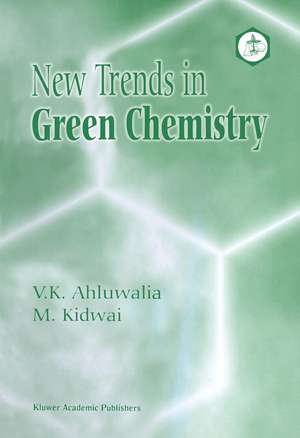New Trends in Green Chemistry
Autor V. K. Ahluwalia, M. Kidwaien Limba Engleză Paperback – 2 aug 2012
Preț: 782.42 lei
Preț vechi: 954.17 lei
-18% Nou
Puncte Express: 1174
Preț estimativ în valută:
149.71€ • 156.73$ • 123.88£
149.71€ • 156.73$ • 123.88£
Carte tipărită la comandă
Livrare economică 05-19 aprilie
Preluare comenzi: 021 569.72.76
Specificații
ISBN-13: 9789401571029
ISBN-10: 9401571023
Pagini: 284
Ilustrații: XVIII, 263 p.
Dimensiuni: 170 x 244 x 15 mm
Greutate: 0.45 kg
Ediția:Softcover reprint of the original 1st ed. 2004
Editura: SPRINGER NETHERLANDS
Colecția Springer
Locul publicării:Dordrecht, Netherlands
ISBN-10: 9401571023
Pagini: 284
Ilustrații: XVIII, 263 p.
Dimensiuni: 170 x 244 x 15 mm
Greutate: 0.45 kg
Ediția:Softcover reprint of the original 1st ed. 2004
Editura: SPRINGER NETHERLANDS
Colecția Springer
Locul publicării:Dordrecht, Netherlands
Public țintă
ResearchCuprins
1. Introduction.- 2. Designing a Green Synthesis.- 2.1 Choice of Starting Materials.- 2.2 Choice of Reagents.- 2.3 Choice of Catalysts.- 2.4 Choice of Solvents.- 3. Basic Principles of Green Chemistry.- 3.1 Prevention of Waste/By-Products.- 3.2 Maximum Incorporation of the Reactants (Starting Materials and Reagents) into the Final Product.- 3.3 Prevention or Minimization of Hazardous Products.- 3.4 Designing Safer Chemicals.- 3.5 Energy Requirements for Synthesis.- 3.6 Selection of Appropriate Solvent.- 3.7 Selection of Starting Materials.- 3.8 Use of Protecting Groups.- 3.9 Use of Catalyst.- 3.10 Products Designed Should be Biodegradable.- 3.11 Designing of Manufacturing Plants.- 3.12 Strengthening of Analytical Techniques.- 4. Green Chemistry in Day-to-Day Life.- 4.1 Dry Cleaning of Clothes.- 4.2 Versatile Bleaching Agent.- 5. Environmental Pollution.- 6. Green Reagent.- 6.1 Dimethylcarbonate.- 6.2 Polymer Supported Reagents.- 7. Green Catalysts.- 7.1 Acid Catalysts.- 7.2 Oxidation Catalysts.- 7.3 Basic Catalysts.- 7.4 Polymer Supported Catalysts.- 8. Phase Transfer Catalysis in Green Synthesis.- 8.1 Introduction.- 8.2 Applications of PTC in Organic Synthesis.- 8.3 Oxidation Using Hydrogen Peroxide Under PTC Condition.- 8.4 Crown Ethers.- 9. Microwave Induced Green Synthesis.- 9.1 Introduction.- 9.2 Applications.- 9.3 Conclusion.- 10. Ultrasound Assisted Green Synthesis.- 10.1 Introduction.- 10.2 Applications of Ultrasound.- 10.3 Conclusion.- 11. Biocatalysts in Organic Synthesis.- 11.1 Introduction.- 11.2 Biochemical (Microbial) Oxidations.- 11.3 Biochemical (Microbial) Reductions.- 11.4 Enzymes Catalysed Hydrolytic Processes.- 12. Aqueous Phase Reactions.- 12.1 Introduction.- 12.2 Diels-Alder Reaction.- 12.3 Claisen Rearrangement.- 12.4 Wittig-Horner Reaction.- 12.5Michael Reaction.- 12.6 Aldol Condensation.- 12.7 Knoevenagel Reaction.- 12.8 Pinacol Coupling.- 12.9 Benzoin Condensation.- 12.10 Claisen-Schmidt Condensation.- 12.11 Heck Reaction.- 12.12 Strecker Synthesis.- 12.13 Wurtz Reaction.- 12.14 Oxidations.- 12.15 Reductions.- 12.16 Polymerisation Reactions.- 12.17 Photochemical Reactions.- 12.18 Electrochemical Synthesis.- 12.19 Miscellaneous Reactions in Aqueous Phase.- 13. Organic Synthesis in Solid State.- 13.1 Introduction.- 13.2 Solid Phase Organic Synthesis Without Using Any Solvent.- 13.3 Solid Supported Organic Synthesis.- 14. Versatile Ionic Liquids as Green Solvents.- 14.1 Green Solvents.- 14.2 Reactions in Acidic Ionic Liquids.- 14.3 Reactions in Neutral Ionic Liquids.- 15. Synthesis Involving Basic Principles of Green Chemistry: Some Examples.- 15.1 Introduction.- 15.2 Synthesis of Styrene.- 15.3 Synthesis of Adipic Acid, Catechol and 3-dehydroshikimic Acid (a potential replacement for BHT).- 15.4 Synthesis of Methyl Methacrylate.- 15.5 Synthesis of Urethane.- 15.6 An Environmentally Benign Synthesis of Aromatic Amines.- 15.7 Selective Alkylation of Active Methylene Group.- 15.8 Free Radical Bromination.- 15.9 Acetaldehyde.- 15.10 Furfural from Biomass.- 15.11 Synthesis of (S)-metolachlor, an Optically Active Herbicide.- 15.12 Synthesis of Ibuprofen.- 15.13 Synthesis of Paracetamol.- 15.14 Green Synthesis of 3-phenyl Catechol.- 15.15 Synthesis of Epoxystyrene.- 15.16 Synthesis of Citral.- 15.17 Synthesis of Nicotinic Acid.- 15.18 Use of Molting Accelerators to Replace More Toxic and Harmful Insecticides.- 15.19 An Environmentally Safe Marine Antifoulant.- Suggested Readings.
Caracteristici
Green chemistry - the pressing need of the world Main features discussed are Designing a green synthesis Basic principles of green chemistry Prevention of environmental pollution Microwave induced and ultrasound assisted green synthesis Organic synthesis in aqueous phase and solid phase Use of green reagents, green catalysts and green solvents





